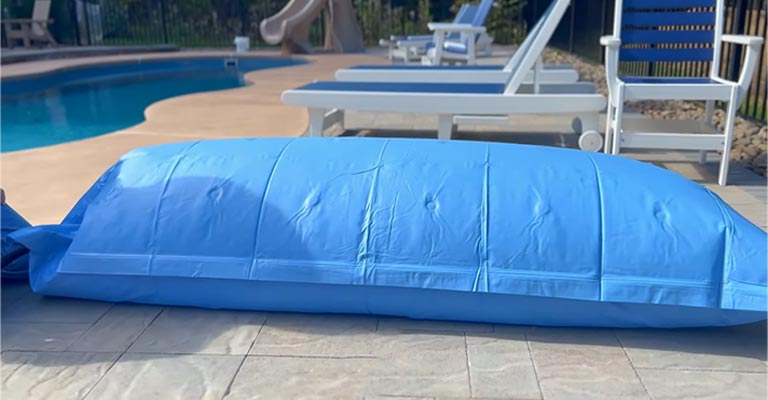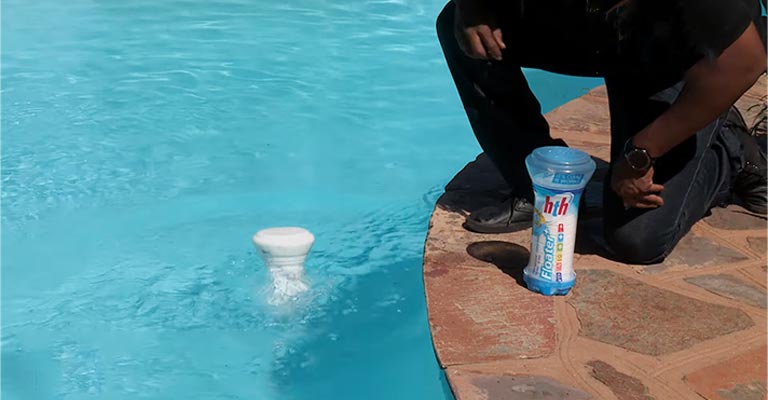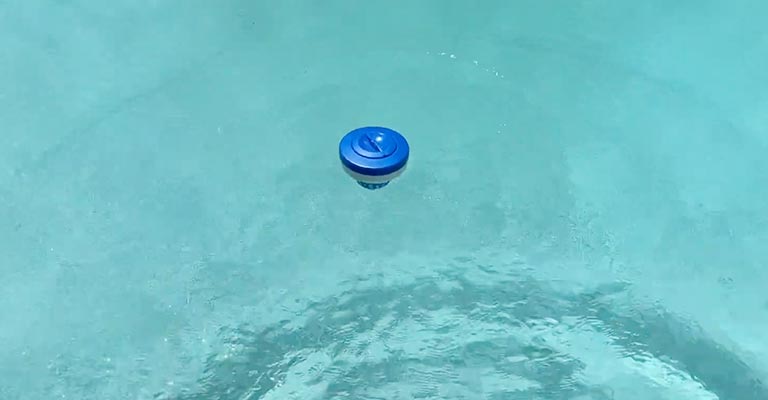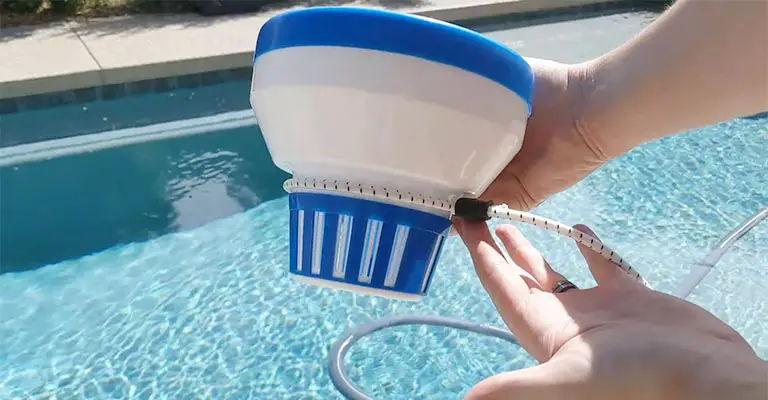Your swimming pool water can be easily chlorinated without any effort by using floatable chlorine dispensers. You will always have a chlorinated pool with this simple device.
It dispenses a controlled amount over a period of time. In light of this, should you keep a chlorine floater in your pool overnight?
Leaving the chlorine floater in the pool overnight is okay, even if you turn off the pool pump. The floating chlorine dispenser will still disperse chlorine gradually as it moves around in the water.
Simply put, you should keep your chlorine floater in the pool almost at all times, even during the night. If you are leaving the floater in the pool, there are some key things to consider.
Here’s what you need to know about leaving chlorine floaters overnight, and when they need to be removed. Let’s get started!
Why Leave the Chlorine Floater in the Pool Overnight?
Leaving the chlorine floater overnight is recommended in “most” cases.
Floating chlorine dispensers can be left in a pool overnight without affecting the swimming pool pump, as they slowly dispense chlorine as they float.
It is more likely that chlorine will be distributed evenly throughout the pool if there is a breeze at night.
Is your chlorine floater always in the pool? Even if it’s empty, it won’t do any harm.
There is no plumbing connection between the chlorine floater and the pool, unlike automatic chlorinators. The floater continues to work even when the pool pump isn’t running.
The water in your pool is most vulnerable to unwanted growth when the pump is off because it will be stagnant. Chlorine can be continuously added during this period with a chlorine floater.
A floater can also be used by pool owners who have automatic chlorinators simply to ensure that chlorination continues through the night.
The chlorine floater will also move around the pool independently if there’s a decent breeze during the night. As the pump is off, this will help distribute chlorine around the pool.
Using a Winter Pool Floater

It’s more than likely because you didn’t use enough residual sanitizer the preceding months if you see a green pond under your cover in spring.
Algae can form while the cover is still on when the temperatures moderate in the spring.
Similar to the chlorine floater you use in the summer, a winter pool floater releases chemicals slowly over time. During the dormant months, though, the winter floater releases chemicals slowly to help prevent growth.
It’s common for winter floaters to hold non-chlorine chemicals that mimic chlorine’s benefits. The chemicals are gentler than chlorine, so they’re less likely to damage the pool.
If you want, you can tie it to the edge of the pool with a string. If needed, you’ll be able to reel it in periodically.
When Not to Use the Chlorine Floater at Night

Even though we just told you to keep the floater in the pool overnight, there is an exception you should consider – though it’s not a hard-and-fast rule!
It’s recommended to remove the chlorine floater from the pool if you use a solar cover at night.
You won’t be able to move the floater around if you keep it under the cover, so you’ll have a higher concentration of chlorine.
The cover can eventually become brittle and damaged if it’s exposed to high chlorine for a long time.
You could also damage your liner if your floater is constantly pinned against the wall by the solar cover due to concentrated chlorine.
I don’t think keeping the floating dispenser under the solar cover will be catastrophic. The dispenser may not have a huge impact on the solar cover’s lifespan anyways, since most solar covers last about two years anyway.
To reduce potential damage, rotate where the floater is every night if you decide to keep the floater in the pool with the cover on.
Make sure the cover doesn’t touch the vinyl liner when you put it on to avoid damaging it.
You could also use a homemade solar cover, in which case damage from a chlorine floater wouldn’t cost that much. When using the DIY pool cover, removing the floater isn’t really worth it.
When To Remove The Chlorine Floater From The Pool
Your chlorine floater needs to be removed from the pool when people will be swimming.
Because the chlorine floater would tip over when the water splashed around, and the contents would fall into the pool.
Floating dispensers might seem like a fun toy to young kids in the pool. If they got their hands on it and started playing with the concentrated chlorine, it would actually be very dangerous.
Chlorine Floaters: How to Use Them

It’s easy to use chlorine floaters. It’s as easy as putting a chlorine tablet in a floater!
For every 5000 gallons of water in your pool, use a three-inch chlorine tablet. For different pool sizes, floating dispensers come in different sizes.
Your chlorine levels should reach a safe range between 2 and 5 ppm before you chlorinate your pool for the first time.
Follow these steps if you don’t know how to use a chlorine floater:
- Remove the top of the chlorine floater and insert the filter screen if it comes with it.
- Fill your chlorine dispenser with the right amount of tablets based on your pool’s size.
- Put the lid back on the chlorine floater.
- Set the dispense rate by adjusting the baffles on the chlorinator.
- Submerge the floater in the pool and it should float to the surface after it’s released all the air bubbles.
- Tether the chlorine floater to the skimmer so it doesn’t get sucked in.
- Move the floater and tether to another section of the pool after three days. By doing this, you’ll make sure there’s no elevated chlorine level in one area of the pool.
- Make sure the tablets in the dispenser are working. Your liner could get stained if the slivers become so small that they slip through the baffles.
- Keep an eye on the chlorine level. You can experiment to find out how many tablets and baffles you need to meet your FC goals.
How Many Chlorine Tablets Are In The Floater?
When I use a chlorine floater, I put 2 or 3 tablets in it. After they dissolve, I retest the water to see if more should be added.
The chlorine levels will stay high while you’re gone if you fill it up a few days ahead of time.
Pros And Cons Of Floating Chlorine Dispensers
We’re guessing you’re really liking the idea of a floating chlorine feeder now (or we’d have lost you by now). Now let’s get into the nitty-gritty and see what the advantages and disadvantages are.
The Pros Of Floating Chlorine Dispensers
These are our favorite things about chlorine dispensers.
Easy To Maintain
Chlorine dispensers are extremely low maintenance, which is one of their main benefits. The chlorinator gets to work as soon as you add the chlorine tablet.
You can get another one for a pretty cheap price if the dispenser chips or stops working for whatever reason.
Low-Cost
The good thing about them is that you can get one pretty easily, and they’re cheaper than automatic chlorinators. Almost all retail outlets and online platforms sell chlorine dispensers for around $10.
You can even make your own dispensers from plastic bottles if you want to go the extra mile!
Easy To Use
It’s hard to deny that these little chlorine floats are incredibly easy to use. It’s just a matter of adding chlorine tablets to the pool water. Is there anything easier?
The Cons Of Floating Chlorine Dispensers
There’s always a downside to every product. What’s the worst that could happen?
Unsafe For Small Children
It’s easy to find floating feeders in a variety of colors and patterns, making them very appealing to babies and small kids. Young kids can be at risk because these chemicals are extremely toxic if they eat them.
Should Be Removed When Swimming
It’s recommended that floating dispensers be removed before anybody gets in the pool. The harsh movement of the water makes it hard for the chlorine to release from the dispenser when the pool is in use.
Eventually, an imbalance in pH levels will occur because the water can’t be sanitized properly. The truth is, I never removed mine.
It’s Hard To Use With Solar Pool Covers
When I bought a solar pool cover, I used floating dispensers too, but now they get stuck along the side because the cover prevents them from floating freely.
Although chlorine will only be dispensed one way, you can purposefully push the chlorine floater under the pool cover and it will still work.
Final Words
Are chlorine floaters safe to leave in the pool overnight?
I’d say yes!
It’s okay to leave the chlorine floater in the pool overnight, even without the pump running. You’ll have minimal oversight and your chlorine levels won’t go up or down!
If you’re using a solar cover, you may want to remove the dispenser before applying it. In this way, you’ll be able to maximize the cover’s lifespan.
If people are using the pool, especially little kids who see it as a toy, you only need to take the chlorine floater out.







